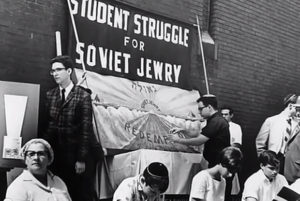 Introducing the State of Israel, the Exodus of Soviet Jewry, and the Upward Mobility of American Jews
Introducing the State of Israel, the Exodus of Soviet Jewry, and the Upward Mobility of American Jews
World War II re-drew the map of world Jewry. Seventy-two percent of European Jewry perished during of the Holocaust, the systematic, state-sponsored persecution and attempted annihilation of Jews (and some other “undesirable” groups) by the Nazi regime and its collaborators between 1933 and 1945–during which six million Jews (and millions of others) were murdered. The world’s largest pre-war Jewish communities, Poland and the U.S.S.R, were decimated; those Eastern European Jews who survived the war faced anti-semitism in the postwar period. Stalin, who controlled not only the U.S.S.R, but also the communist satellite states of Eastern Europe, closed Jewish cultural institutions and imprisoned hundreds of Jews.
Stalin’s death in 1953 brought some relief to Eastern European Jews, but Middle Eastern politics presented a new stumbling block to Jewish life. The Soviet government, fearing the groundswell of Jewish self-identification occasioned by the establishment of the state of Israel, branded Zionism illegal and closed all secular Jewish institutions. In 1971, the Soviets began to permit Jewish emigration but maintained tight reigns over who was allowed to leave. Those Jews who were refused emigration permits (“refuseniks”) were deemed untrustworthy and often lost their jobs. In total, over 250,000 Soviet Jews emigrated during the 1970s. A majority of Soviet émigrés settled in Israel; others moved to the United States, Canada and Australia.
A new regional pattern emerged for the Jews of western Europe after World War II. Whereas German Jewry had been the Jewish cultural touchstone of pre-war Europe, the postwar period saw the Jewish communities of Britain and France become the largest and most important in the region. While British Jewry ultimately declined in numbers as a result of assimilation and intermarriage (issues faced by all western Jewish communities in the postwar period), the Jewish community in France grew as a result of emigration of Jews from Northern Africa.
Immediately after the war, approximately 250,000 Jewish displaced persons left Europe for the United States or Israel. These two nations became the main stages for postwar Jewish life.
After decades of struggle under British Mandate, the fate of Palestine was placed in the hands of the United Nations. The United Nations voted to partition Palestine into two sovereign states, Arab and Jewish. The Arabs rejected this proposal and pledged to prevent its implementation by whatever means necessary. The Jews accepted the plan and founded the Jewish state, Israel, in May 1948. The day after Israel became a state, a War of Independence with her neighbors (Egypt, Trans-Jordan, Syria, Lebanon and Iraq) began. The war ended in 1949, but the existential and physical questions about borders and populations that existed then continued.
The demands of serving as a haven for Jews occupied Israel’s internal resources during her early years. Refugees flooded into the country- first displaced persons from Europe, followed by Jews from Arab lands, then Jews from Ethiopia, and the Soviet Union. Israel’s Law Of Return, which grants citizenship to any Jew, resulted in growing pains for the new state. Israel supported a population wherein a majority of the citizens were Jews– who looked different from one another, spoke different languages, had varied histories, practiced different customs, and held a variety of opinions about religion and its role in their lives. The challenge was to make these people into one nation.
The United States had practice and a decent success rate at integrating different people and cultures into a single nation. The American Jewish community had, in fact, coalesced during the period between the two World Wars from an immigrant community divided by language, politics, and culture into an English-speaking, upwardly mobile American citizenry.
Mobility was a key feature of the post-war experience for American Jews; the American Jewish community moved up the economic ladder and out of cities toward the suburbs and the sunbelt in the postwar period. Movements, both political and cultural, were also attractive to postwar American Jews. The counterculture, feminism, and civil rights benefited from significant Jewish participation.
After the 1967 war, American Jews moved toward unwavering support of Israel. The threatened annihilation of the Jewish State by her neighbors brought to the fore memories of extermination that would assume a front seat in the American Jewish collective psyche. The unprecedented philanthropic efforts of American Jews toward support of Israel in and after 1967 demonstrated the practical and psychological commitment that American Jewry felt toward Israel.
The Jewish communities of Latin America, numbering nearly 500,000 in the postwar period, struggled to maintain Jewish continuity in the face of increasing intermarriage, decreasing religious practice, and in the case of Argentina, an anti-semitic military dictatorship (1976-1982). On the other side of the world, the 120,000 Jews of South Africa enrolled nearly all of the country’s Jewish youth in day schools, an unusual example of commitment to Judaism in the postwar diaspora.